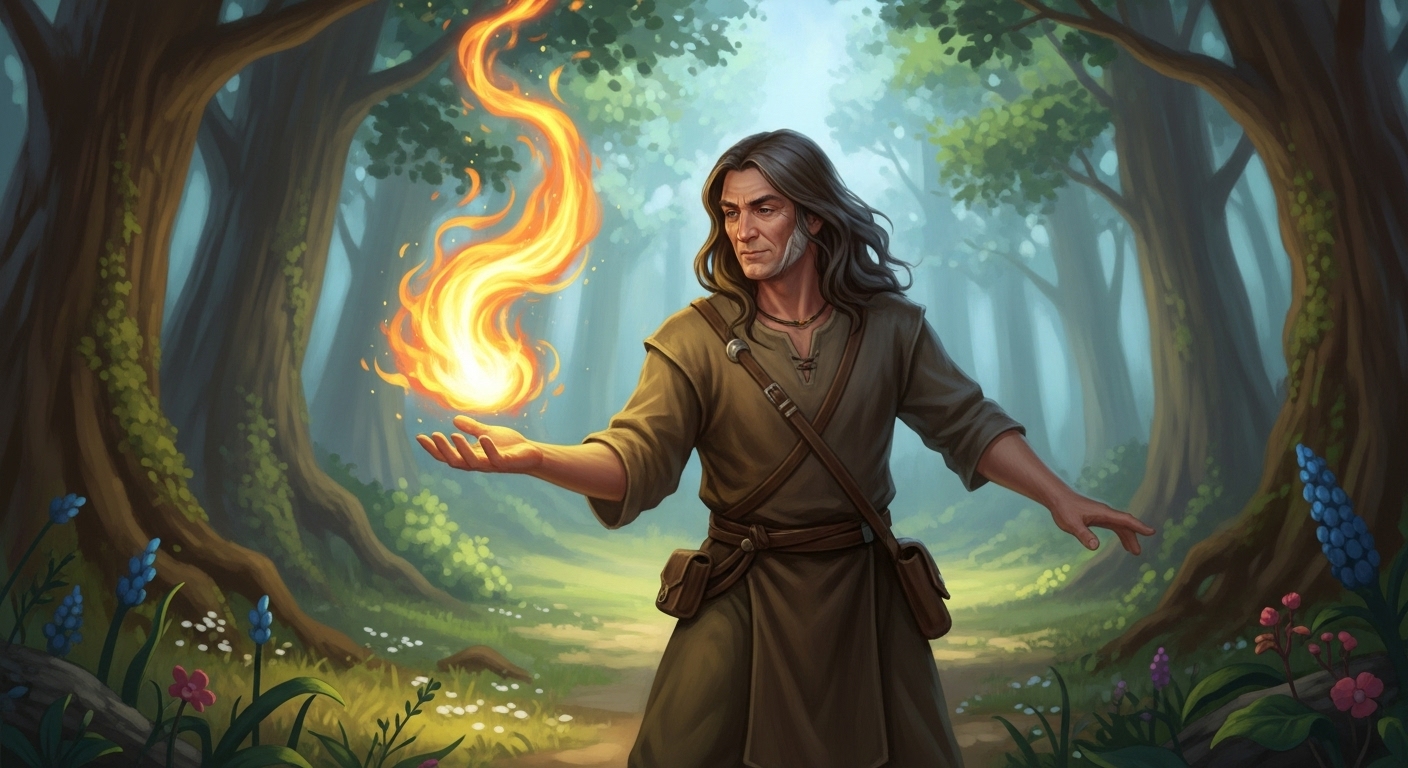Produce Flame

- Level: Cantrip
- School: Conjuration
- Class: Druid
- Casting Time: Bonus Action
- Range: Self
- Components: V, S
- Duration: 10 minutes
A flickering flame appears in your hand and remains there for the duration. While there, the flame emits no heat and ignites nothing, and it sheds Bright Light in a 20-foot radius and Dim Light for an additional 20 feet. The spell ends if you cast it again.
Until the spell ends, you can take a Magic action to hurl fire at a creature or an object within 60 feet of you. Make a ranged spell attack. On a hit, the target takes 1d8 Fire damage.
Cantrip Upgrade. The damage increases by 1d8 when you reach levels 5 (2d8), 11 (3d8), and 17 (4d8).
Tactical Usage
Dual-Purpose Cantrip. Produce Flame provides both reliable illumination and competitive damage output, making it exceptionally versatile for druids who need both utility and combat capability.
Bonus Action Economy. The bonus action casting enables efficient action economy management, allowing other actions while maintaining flame availability for attacks or lighting.
Persistent Light Source. The 10-minute duration with 20-foot bright light radius provides substantial illumination for exploration, social encounters, or tactical positioning.
Spell Combinations
Combat Flexibility. The flame can be hurled as an attack while still providing light, offering tactical flexibility between offense and utility within the same spell effect.
Stealth Considerations. The bright light might compromise stealth operations, though the magical action attack option provides excellent backup damage when concealment fails.
Environmental Enhancement. Combining with other druidic magic like Entangle or nature-based spells creates thematic spell combinations that reinforce natural magic themes.
Material Component Details
Component-Free Advantage. Produce Flame requires no material components, making it reliable in situations where equipment is restricted, lost, or unavailable.
Gesture Requirements. Somatic components require one free hand for both casting and maintaining the flame, which might affect shield usage or other equipment considerations.
Verbal Components. The spell requires spoken incantations that might alert others to magical activity, though the visual flame effect typically makes concealment difficult anyway.
Creator Notes
Reliable Druid Tool. Produce Flame exemplifies druidic versatility, providing both practical utility and combat effectiveness in a single cantrip that remains useful throughout character progression.
Light Source Management. The spell offers sustainable illumination that doesn't require materials or equipment, making it valuable for extended exploration or survival situations.
Damage Scaling Relevance. The cantrip maintains combat relevance through level progression while providing unique utility benefits unavailable from other damage cantrips.
Environmental Interactions
Fire Safety. The flame emits no heat and ignites nothing while held, preventing accidental fires or environmental damage despite its magical fire nature.
Illumination Benefits. The substantial light radius dramatically improves visibility in dark environments, caves, dungeons, or nighttime operations.
Wind Resistance. As a magical flame, the effect resists normal wind and weather conditions that would extinguish mundane light sources.
Common Rulings & Clarifications
Attack Action Requirements. Hurling the flame requires a Magic action, preventing its use as part of other actions or bonus action combinations.
Single Target Limitation. Each attack targets one creature or object, requiring multiple actions to engage multiple enemies rather than providing area effects.
Range Considerations. The 60-foot range for attacks provides excellent reach for a cantrip, enabling safe engagement distances while maintaining light benefits.
Duration Management. The spell ends if cast again, preventing multiple flame creation but allowing refreshing when needed for continued utility.
Alternative Applications
Signaling Applications. The bright flame serves as an excellent signal for communication, marking locations, or coordinating with distant allies during operations.
Intimidation Support. Magical fire in hand creates impressive displays during social encounters, supporting intimidation attempts or demonstrating magical power.
Environmental Interaction. While the flame doesn't ignite materials directly, it can be hurled to trigger fire-sensitive mechanisms, illuminate combustible materials, or threaten flammable opponents.
Related Spells
Light Cantrip Comparison. Light provides longer duration illumination without damage capability, while Dancing Lights offers multiple light sources with movement options.
Fire Magic Progression. Produce Flame leads to more powerful fire spells like Burning Hands, Flaming Sphere, and Fireball as druidic fire magic develops.
Utility Cantrip Options. Druidcraft provides minor nature effects, while Guidance offers bonus enhancements, showing different approaches to druidic cantrip utility.
Scaling Analysis
Excellent Damage Progression. The 1d8 to 4d8 scaling keeps Produce Flame competitive with weapon attacks throughout character progression while maintaining utility benefits.
Sustained Utility Value. Light production remains valuable regardless of character level, making this cantrip useful in both early and late campaign phases.
Resource Independence. As a cantrip, Produce Flame provides unlimited utility and damage that becomes increasingly valuable as spell slots are reserved for higher-level applications.
Narrative Flavor
Natural Fire Magic. The flame should reflect druidic connection to natural fire rather than arcane energy, perhaps resembling campfire warmth or forest fire intensity.
Personal Manifestation. Different druids might create flames with unique characteristics reflecting their personality, grove affiliation, or elemental connection preferences.
Combat Descriptions. Hurled flames can be described as natural fire bursts, elemental attacks, or primal energy expressions that reinforce the druidic theme and connection to elemental forces.